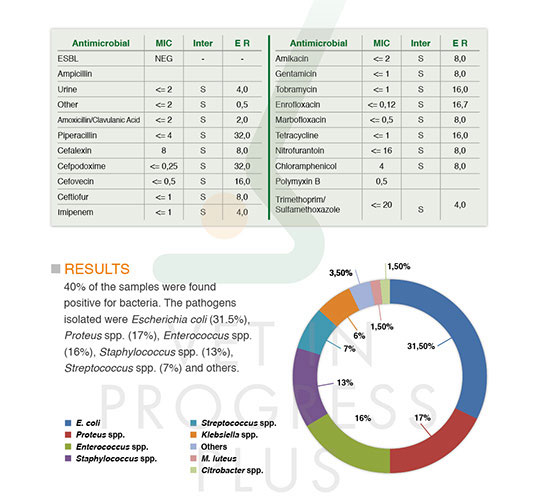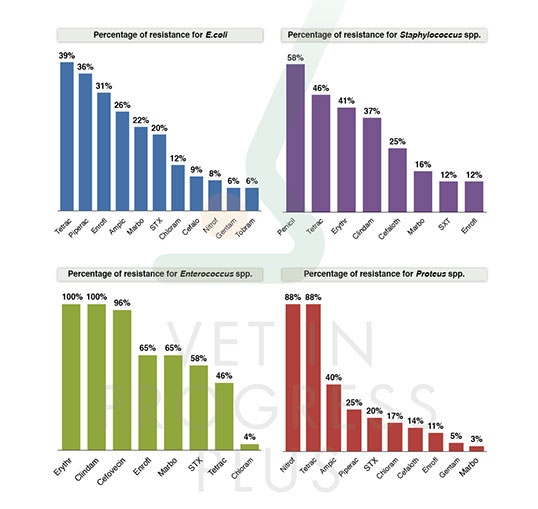BACTERIAL UROPATHOGENS IN 200 CASES OF URINARY TRACT INFECTION AND THE ANTIBIOTIC RESISTANCES ENCOUNTERED
K. Bitchava, D.V. Bitchava, Th. Papakostas
Department of Microbiology, Veterinary Laboratories “Vet In Progress Plus”, Greece
INTRODUCTION
Urinary tract infection (UTI) is one of the most common bacterial infections encountered by small animal veterinarians, while the urine samples sent to the laboratory for microbiology test are almost 60% of the routine E. coli, Proteus spp. Enterococcus spp., Staphylococcus spp. and Klebsiella spp, are considered the most frequent pathogens encountered (Ball et al, 2008). Aerobic bacterial culture and susceptibility testing should be performed in all samples to identify the presence of resistant bacteria (Weese et al, 2011).
OBJECTIVES
The aim of this study was to investigate the pathogens responsible for urinary tract infections in dogs and cats and also their resistance patterns using a s us with minimum inhibitory concentrations (MIC). hat provides
METHODS
Urine samples were collected and sent to the laboratory within 12 hours. The samples were taken either by catheterization, using the mid-stream method or by cystocentesis from 500 clinically-suspected cases of urinary tract infections and tested bacteriologically using standard procedures. Both the identification and the antimicrobial susceptibility test were performed on the VITEK 2 system (Biomerieux). The efficacy ratios of the antibiotics were also calculated using the Minimum Inhibitory Concentrations provided automatically by the instrument fed automatically by the instrument.

E. coli showed the highest percentage of resistance to tetracycline (39%) and Proteus spp. to tetracycline and nitrofurantoin (88%). Staphylococci showed 58% resistance to VET Enterococci 100%; to cindamycin E penicillin, while Enterococci were 96% resistant to cefovecin and 100% to clindamycin and erythromycin.

CONCLUSIONS
VET This study showed that E. coli isolates were the predominant pathogens together with Proteus spp., Enterococcus spp., Staphylococcus spp. and Streptococcus spp. Moreover there were many resistances encountered for the antibiotics tested such as the resistance of Enterococcus spp. to cefovecin, of E. coli to tetracycline and fluoroquinolones compared to the other studies (Ball et al, 2008). Improper therapy can lead to a variety of patient health, economic, public health and regulatory concerns (Weese et al 2001). As drug resistance among bacterial pathogens is an evolving process, an accurate antimicrobial susceptibility test with MICs and efficacy ratios should be conducted to provide veterinarians with the most effective treatment of UTIS and prevent the emergence of multidrug resistant pathogens.
REFERENCES
K.R. Ball, J.E. Rubin, M. Chirino-Trejo, P.M. Dowling (2008) Antimicrobial resistance and prevalence of canineuropathogens at the Western College of Veterinary Medicine Veterinary Teaching Hospital. The Cana dian Veterinary Journal 49(10) 985-990.
J.S. Weese, J.M. Blondeau, D. Boothe, E.B. Breitschwerdt, L. Guardabassi, A. Hillier, D.H. Lloyd, M.G. Papich, S.C. Rankin, J.D. Turnidge and J.E. Sykes (2011) Antimicrobial Use Guidelines for Treatment of Urinary Tract Disease in Dogs and Cats: Antimicrobial Guidelines Working Group of the International Society for Companion Animal Infectious Diseases, Veterinary Medicine International, 263768.
